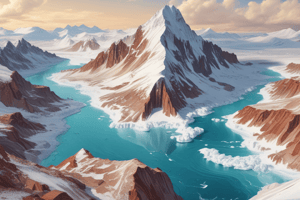Podcast
Questions and Answers
Waarom accumuleert sneeuw in hoogliggende of hooggelegen gebieden?
Waarom accumuleert sneeuw in hoogliggende of hooggelegen gebieden?
- Vanwege de hoge temperaturen en lage neerslag
- Vanwege de aanwezigheid van meren en rivieren
- Vanwege de sterke wind en lage luchtvochtigheid
- Vanwege de lage temperaturen en hoge neerslag (correct)
Wat is de naam van het proces waarbij sneeuw kristallen worden samengedrukt en omgevormd tot grotere ijskristallen?
Wat is de naam van het proces waarbij sneeuw kristallen worden samengedrukt en omgevormd tot grotere ijskristallen?
- Sublimatie
- Recrystallisatie (correct)
- Accumulatie
- Ablatie
Welke factor beïnvloedt het stromen van ijs in een gletsjer?
Welke factor beïnvloedt het stromen van ijs in een gletsjer?
- De temperatuur van de omgeving
- De aanwezigheid van bergachtig terrein
- De hoeveelheid neerslag in het gebied
- De dikte van de ijslaag (correct)
Wat is het proces waarbij een gletsjer massa verliest door het afbreken van stukken ijs in de oceaan of een meer?
Wat is het proces waarbij een gletsjer massa verliest door het afbreken van stukken ijs in de oceaan of een meer?
Wat is de naam van het proces waarbij sneeuw wordt omgevormd tot een dichte laag firn?
Wat is de naam van het proces waarbij sneeuw wordt omgevormd tot een dichte laag firn?
Welke van de volgende processen is verantwoordelijk voor het verlies van massa door een gletsjer?
Welke van de volgende processen is verantwoordelijk voor het verlies van massa door een gletsjer?
Study Notes
Glacier Formation Processes
Accumulation of Snow
- Snow accumulates in high-latitude or high-altitude regions due to low temperatures and high precipitation
- Snow can come from various sources, including:
- Direct precipitation
- Avalanche deposits
- Wind-blown snow
- Accumulated snow is compacted by its own weight, forming a dense layer of firn
Transformation of Snow to Ice
- Firn is transformed into ice through a process called recrystallization, where snow crystals are compressed and recrystallized into larger ice crystals
- This process occurs due to the weight of overlying snow and the pressure exerted by it
- Recrystallization can take years to decades, depending on the temperature and pressure conditions
Glacier Flow
- Once the ice is formed, it begins to flow downhill under its own weight, driven by gravity
- The flow of ice is influenced by factors such as:
- Surface slope
- Ice thickness
- Bedrock topography
- Basal lubrication (e.g., presence of water or sediments)
- Glacier flow can occur through various mechanisms, including:
- Plastic deformation (creep)
- Basal sliding
- Bedrock entrainment
Calving and Ablation
- Glaciers can lose mass through calving, where chunks of ice break off into the ocean or a lake
- Ablation is the process of glacier mass loss through melting, sublimation, or other means
- Calving and ablation are important processes that shape the glacier's front and control its overall mass balance
Gletsjerformeerprocessen
Sneeuwaccumulatie
- Sneeuwaccumulatie vindt plaats in hooggelegen of hoge breedtegraden regio's door lage temperaturen en hoge neerslag
- Sneeuw kan afkomstig zijn uit diverse bronnen, waaronder:
- Directe neerslag
- Lawinedeposities
- Windgedreven sneeuw
- Accumuleerde sneeuw wordt samengedrukt door zijn eigen gewicht, vormend een dichte laag van firn
Transformatie van Sneeuw naar IJs
- Firn wordt getransformeerd naar ijs door een proces genaamd recrystallisatie, waarbij sneeuwkristallen worden samengedrukt en herkristalliseerd tot grotere ijskristallen
- Dit proces vindt plaats door het gewicht van overliggend sneeuw en de druk die het uitoefent
- Recrystallisatie kan jaren tot decennia duren, afhankelijk van de temperatuur- en drukomstandigheden
Gletsjerstroom
- Eenmaal het ijs is gevormd, begint het te stromen bergafwaarts onder zijn eigen gewicht, aangedreven door zwaartekracht
- De stroom van ijs wordt beïnvloed door factoren zoals:
- Opgestuwde helling
- Ijsdikte
- Bedrocktopografie
- Basale smering (bijvoorbeeld aanwezigheid van water of sedimenten)
- Gletsjerstroom kan plaatsvinden door verschillende mechanismen, waaronder:
- Plastische deformatie (kruip)
- Basale glijden
- Bedrock-insluiting
Kalving en Ablatie
- Gletsjers kunnen massa verliezen door kalving, waarbij stukken ijs afbreken in de oceaan of een meer
- Ablatie is het proces van massa-verlies van een gletsjer door smelten, sublimatie of andere middelen
- Kalving en ablatie zijn belangrijke processen die de gletsjerfront vormen en het algemene massabalans controleren
Studying That Suits You
Use AI to generate personalized quizzes and flashcards to suit your learning preferences.
Description
Learn about the accumulation of snow and its transformation into ice through recrystallization, forming glaciers.




